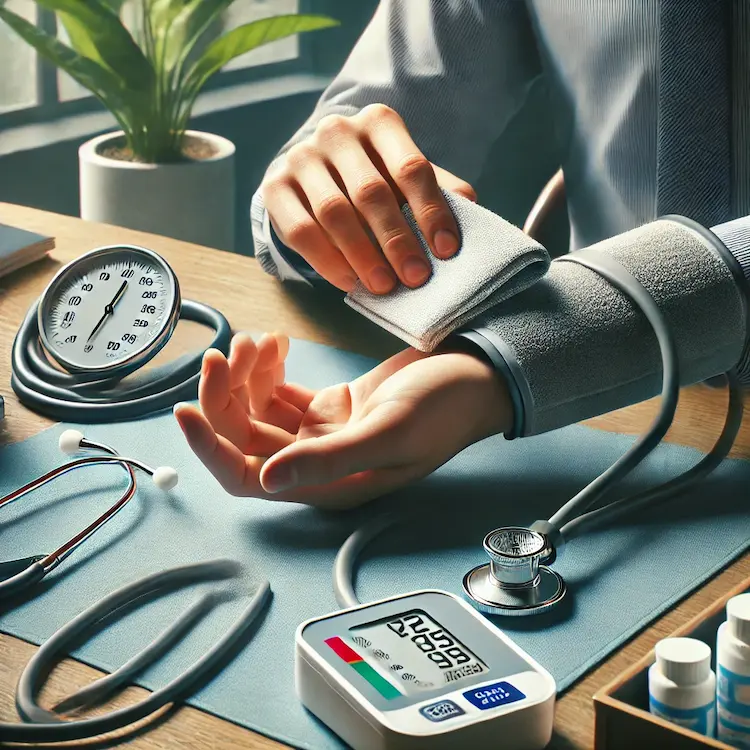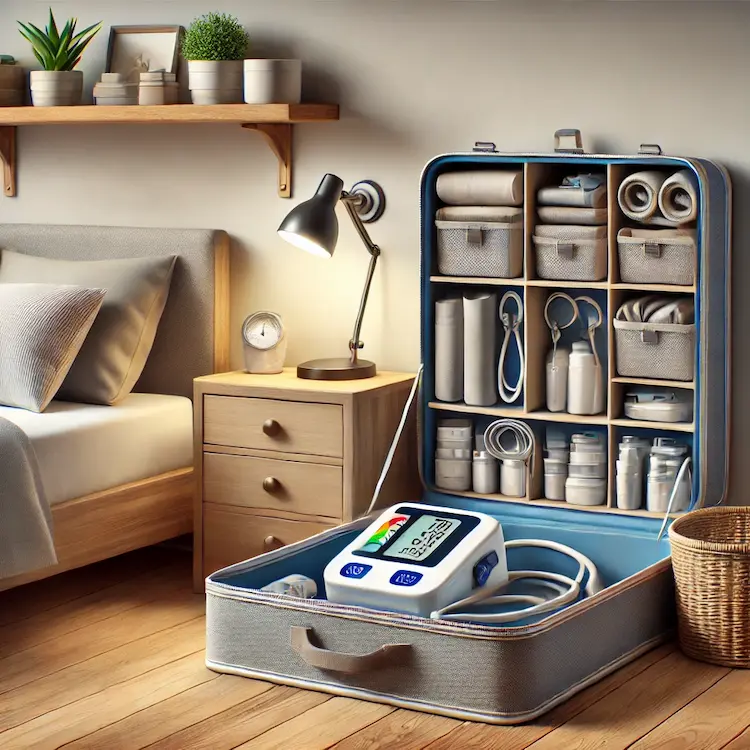Blood pressure monitors are indispensable tools for individuals managing hypertension or other cardiovascular conditions. Ensuring these devices are clean and properly stored not only extends their lifespan but also guarantees the accuracy of readings, which is paramount for effective health management.
Importance of Proper Maintenance
Proper maintenance of blood pressure monitors is critical for several reasons:
- Accuracy: Dirt, dust, and residue can interfere with the device’s sensors, leading to inaccurate readings.
- Hygiene: Regular cleaning prevents the buildup of bacteria and viruses, reducing the risk of infections, especially when the device is shared among multiple users.
- Longevity: Proper care minimizes wear and tear, extending the device’s functional lifespan and reducing the need for frequent replacements.
- Cost-Effectiveness: Maintaining the device reduces the need for repairs or replacements, offering economic benefits to users.

Health and Societal Impacts
Health Impacts
Accurate blood pressure readings are essential for diagnosing and managing hypertension, a condition affecting approximately 1.13 billion people worldwide. Inaccurate readings due to poor device maintenance can lead to misdiagnosis, inappropriate treatment, and increased risk of heart disease, stroke, and kidney failure.
Societal Impacts
The prevalence of hypertension poses a significant public health challenge, leading to substantial healthcare costs and loss of productivity. Ensuring the reliability of blood pressure monitors through proper maintenance can mitigate these impacts by improving disease management and reducing the burden on healthcare systems.
Cleaning Your Blood Pressure Monitor
Regular cleaning of your blood pressure monitor involves both the cuff and the device itself. Here’s how to effectively clean each component.
Manual Cleaning Methods
- Cuff Cleaning:
- Detachable Cuffs: Remove the cuff from the monitor if possible.
- Wipe Down: Use a soft, damp cloth to wipe the cuff. Avoid soaking it to prevent moisture damage.
- Stain Removal: For stubborn stains, use mild soap mixed with water. Gently rub the stained area and rinse with a clean damp cloth.
- Device Body:
- Surface Wiping: Use a dry or slightly damp cloth to clean the exterior. Pay attention to buttons and display areas.
- Avoid Liquid Exposure: Do not immerse the device in water or use harsh cleaning agents, as this can damage internal components.
Using Cleaning Tools and Products
- Antibacterial Wipes:
- Ideal for disinfecting surfaces without leaving moisture residue.
- Ensure the wipes are alcohol-based but not overly harsh to prevent degradation of materials.
- Microfiber Cloths:
- Effective for removing dust and fingerprints without scratching surfaces.
- Can be used dry or slightly dampened with water or mild soap solution.
- UV-C Sanitizers:
- Advanced method using ultraviolet light to kill bacteria and viruses.
- Place the device in the sanitizer as per manufacturer instructions for thorough disinfection.
Frequency of Cleaning
- Daily: Wipe down the cuff and device after each use to remove sweat and prevent bacterial buildup.
- Weekly: Perform a more thorough cleaning with mild soap and water, ensuring all parts are properly dried before storage.
- Monthly: Inspect the device for any signs of wear or damage and clean any hard-to-reach areas.
Storage Best Practices
Proper storage ensures your blood pressure monitor remains in optimal condition and is ready for accurate readings whenever needed.
Environmental Considerations
- Temperature Control:
- Store the device in a cool, dry place away from direct sunlight and extreme temperatures, which can affect battery life and device functionality.
- Humidity Levels:
- Avoid humid environments to prevent moisture damage and mold growth on the cuff and device components.
- Avoiding Physical Stress:
- Keep the device away from areas where it can be knocked over or subjected to physical stress, such as high shelves or crowded cabinets.
Proper Storage Techniques
- Original Packaging:
- When not in use, store the monitor in its original packaging or a protective case to shield it from dust and physical damage.
- Cuff Management:
- Ensure the cuff is not twisted or bent during storage to maintain its integrity and functionality.
- Cable Management:
- Coil cables neatly and secure them with ties to prevent tangling and potential damage.
- Accessibility:
- Store the monitor in an easily accessible location to encourage regular use and maintenance.
Comparative Analysis of Cleaning Methods
| Cleaning Method |
Pros |
Cons |
| Manual Cleaning |
Cost-effective, no special tools required |
Time-consuming, inconsistent results |
| Antibacterial Wipes |
Quick, effective disinfection |
May not remove all types of dirt |
| Microfiber Cloths |
Gentle on surfaces, reusable |
Requires regular washing |
| UV-C Sanitizers |
High level of disinfection, chemical-free |
Expensive, requires specific equipment |
Each cleaning method offers unique advantages and potential drawbacks. Manual cleaning is accessible but may lack thoroughness, while UV-C sanitizers provide superior disinfection but at a higher cost. Selecting the appropriate method depends on individual needs, budget, and desired level of cleanliness.
Practical Tips and Steps
- Establish a Cleaning Routine:
- Schedule regular cleaning sessions to ensure the device remains hygienic and functional.
- Use Appropriate Cleaning Agents:
- Stick to mild soaps and alcohol-based wipes to prevent damage to the device materials.
- Dry Thoroughly:
- After cleaning, ensure all components are completely dry before reassembling or storing to prevent moisture-related issues.
- Inspect Regularly:
- Check for signs of wear, such as frayed cables or damaged cuffs, and replace parts as necessary to maintain accuracy.
- Educate Users:
- If the device is shared among multiple users, provide instructions on proper cleaning and storage to ensure consistent maintenance.
- Avoid Shared Use Without Cleaning:
- Prevent the spread of germs by cleaning the device thoroughly between uses, especially in shared environments.

Visual Aids
Table 1: Comparative Analysis of Cleaning Methods
| Cleaning Method |
Pros |
Cons |
| Manual Cleaning |
Cost-effective, no special tools required |
Time-consuming, inconsistent results |
| Antibacterial Wipes |
Quick, effective disinfection |
May not remove all types of dirt |
| Microfiber Cloths |
Gentle on surfaces, reusable |
Requires regular washing |
| UV-C Sanitizers |
High level of disinfection, chemical-free |
Expensive, requires specific equipment |
Conclusion
Maintaining your blood pressure monitor through regular cleaning and proper storage is essential for ensuring accurate readings, prolonging the device’s lifespan, and safeguarding your health. By adhering to best practices and establishing a consistent maintenance routine, you can maximize the benefits of your blood pressure monitoring efforts and contribute to better cardiovascular health outcomes.
Key Takeaways
- Accuracy Matters: Clean devices provide reliable readings crucial for effective health management.
- Regular Maintenance: Daily and weekly cleaning routines prevent bacterial buildup and device degradation.
- Proper Storage: Protecting the device from environmental factors extends its lifespan and maintains functionality.
- Choose the Right Methods: Select cleaning methods that balance effectiveness with practicality and cost.
- Educate Users: Proper usage and maintenance knowledge ensure consistent device performance, especially in shared settings.
Actionable Recommendations
- Set a Cleaning Schedule: Incorporate daily wipes and weekly thorough cleanings into your routine.
- Invest in Quality Cleaning Tools: Use microfiber cloths and antibacterial wipes to ensure effective maintenance without damaging the device.
- Store Properly: Keep your blood pressure monitor in a cool, dry place, preferably in its original packaging or a protective case.
- Regularly Inspect the Device: Check for wear and tear monthly and replace any damaged parts promptly.
- Educate All Users: If the monitor is shared, ensure everyone understands and follows the maintenance guidelines to maintain hygiene and accuracy.

